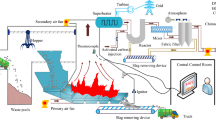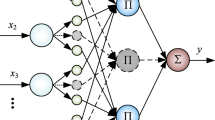Abstract
Due to the large uncertainty in the municipal solid waste incineration (MSWI) process, the furnace temperature of the MSWI process is difficult to control and the controller is updated frequently. To improve the accuracy and reduce the number of controller updates, a novel event-triggered control method based correntropy self-organizing TS fuzzy neural network (ET-CSTSFNN) is proposed. Firstly, the neurons of the rule layer are grown or pruned adaptively based on activation intensity and control error to meet the dynamic change of the actual operating condition. Meanwhile, the performance index is designed based on the correntropy of tracking errors, and the parameters of the controller are adjusted by gradient descent algorithm. Secondly, a fixed threshold event-triggered condition is designed to determine whether the current controller is updated or not. The stability of the control system is proved based on the Lyapunov stability theory. Finally, the furnace temperature control experiments are conducted based on the actual data of a municipal solid waste incineration plant in Beijing. The experimental results show that the proposed ET-CSTSFNN controller shows a better control performance, which can reduce the number of the controller update significantly while achieving accurate furnace temperature control compared with other traditional control methods.
Similar content being viewed by others
References
Zhu Y, Zhang Y, Luo D, et al. A review of municipal solid waste in China: Characteristics, compositions, influential factors and treatment technologies. Environ Dev Sustain, 2021, 23: 6603–6622
Ding Y, Zhao J, Liu J W, et al. A review of China’s municipal solid waste (MSW) and comparison with international regions: Management and technologies in treatment and resource utilization. J Clean Prod, 2021, 293: 126144
Chen X, Li J, Liu Q, et al. Emission characteristics and impact factors of air pollutants from municipal solid waste incineration in Shanghai, China. J Environ Manage, 2022, 310: 114732
Voss R, Lee R P, Seidl L, et al. Global warming potential and economic performance of gasification-based chemical recycling and incineration pathways for residual municipal solid waste treatment in Germany. Waste Manage, 2021, 134: 206–219
Karak T, Bhattacharyya P, Das T, et al. Non-segregated municipal solid waste in an open dumping ground: A potential contaminant in relation to environmental health. Int J Environ Sci Technol, 2013, 10: 503–518
Liu Y, Liu J. Mechanism and dynamic evolution of leachate collection system clogging in MSW landfills in China. Waste Manage, 2021, 120: 314–321
Lu J W, Zhang S, Hai J, et al. Status and perspectives of municipal solid waste incineration in China: A comparison with developed regions. Waste Manage, 2017, 69: 170–186
Ferronato N, Gorritty Portillo M A, Guisbert Lizarazu E G, et al. The municipal solid waste management of La Paz (Bolivia): Challenges and opportunities for a sustainable development. Waste Manag Res, 2018, 36: 288–299
Margallo M, Taddei M B M, Hernández-Pellón A, et al. Environmental sustainability assessment of the management of municipal solid waste incineration residues: A review of the current situation. Clean Techn Environ Policy, 2015, 17: 1333–1353
del Valle-Zermeño R, Barreneche C, Cabeza L F, et al. MSWI bottom ash for thermal energy storage: An innovative and sustainable approach for its reutilization. Renew Energy, 2016, 99: 431–436
Shen K, Lu J, Li Z, et al. An adaptive fuzzy approach for the incineration temperature control process. Fuel, 2005, 84: 1144–1150
Chen W C, Chang N B, Chen J C. GA-based fuzzy neural controller design for municipal incinerators. Fuzzy Sets Syst, 2002, 129: 343–369
Kebria P M, Khosravi A, Nahavandi S, et al. Adaptive type-2 fuzzy neural-network control for teleoperation systems with delay and uncertainties. IEEE Trans Fuzzy Syst, 2019, 28: 2543–2554
Dian S, Hu Y, Zhao T, et al. Adaptive backstepping control for flexible-joint manipulator using interval type-2 fuzzy neural network approximator. Nonlinear Dyn, 2019, 97: 1567–1580
Huang S J, Lin W C. Adaptive fuzzy controller with sliding surface for vehicle suspension control. IEEE Trans Fuzzy Syst, 2003, 11: 550–559
Medjber A, Guessoum A, Belmili H, et al. New neural network and fuzzy logic controllers to monitor maximum power for wind energy conversion system. Energy, 2016, 106: 137–146
Ai M, Xie Y, Xie S, et al. Data-driven-based adaptive fuzzy neural network control for the antimony flotation plant. J Franklin Institute, 2019, 356: 5944–5960
Han H G, Zhang L, Liu H X, et al. Multiobjective design of fuzzy neural network controller for wastewater treatment process. Appl Soft Comput, 2018, 67: 467–478
Qiao J, Zhang W, Han H. Self-organizing fuzzy control for dissolved oxygen concentration using fuzzy neural network1. J Intel Fuzzy Syst, 2016, 30: 3411–3422
Wang N, Er M J, Han M. Dynamic tanker steering control using generalized ellipsoidal-basis-function-based fuzzy neural networks. IEEE Trans Fuzzy Syst, 2014, 23: 1414–1427
Chen X, Yang J, Liang J, et al. Recursive robust least squares support vector regression based on maximum correntropy criterion. Neurocomputing, 2012, 97: 63–73
Chen B, Ma R, Yu S, et al. Granger causality analysis based on quantized minimum error entropy criterion. IEEE Signal Process Lett, 2019, 26: 347–351
Nayyeri M, Sadoghi Yazdi H, Maskooki A, et al. Universal approximation by using the correntropy objective function. IEEE Trans Neural Netw Learn Syst, 201, 29: 4515–4521
He R, Zheng W S, Hu B G. Maximum correntropy criterion for robust face recognition. IEEE Trans Pattern Anal Mach Intell, 2011, 33: 1561–1576
Heemels W P M H, Donkers M C F, Teel A R. Periodic event-triggered control for linear systems. IEEE Trans Automat Contr, 2013, 58: 847–861
Shen B, Wang Z, Qiao H. Event-triggered state estimation for discrete-time multidelayed neural networks with stochastic parameters and incomplete measurements. IEEE Trans Neural Netw Learn Syst, 2017, 28: 1152–1163
Li B, Wang Z, Ma L. An event-triggered pinning control approach to synchronization of discrete-time stochastic complex dynamical networks. IEEE Trans Neural Netw Learn Syst, 2018, 29: 5812–5822
Wang X X, Liu Z X, Chen Z Q. Event-triggered fault-tolerant consensus control with control allocation in leader-following multi-agent systems. Sci China Tech Sci, 2021, 64: 879–889
Boruah N, Roy B K. Event triggered nonlinear model predictive control for a wastewater treatment plant. J Water Process Eng, 2019, 32: 100887
Du S, Yan Q, Qiao J. Event-triggered PID control for wastewater treatment plants. J Water Process Eng, 2020, 38: 101659
Feng Z, Li Y, Sun B, et al. A trend-based event-triggering fuzzy controller for the stabilizing control of a large-scale zinc roaster. J Process Control, 2021, 97: 59–71
Sinha A, Mishra R K. Control of a nonlinear continuous stirred tank reactor via event triggered sliding modes. Chem Eng Sci, 2018, 187: 52–59
Li F, Cao X, Zhou C, et al. Event-triggered asynchronous sliding mode control of CSTR based on markov model. J Frankl Inst, 2021, 358: 4687–4704
Author information
Authors and Affiliations
Corresponding author
Additional information
This work was supported by the National National Science Foundation of China (Grant Nos. 62073006 and 62021003) and Beijing Natural Science Foundation (Grant No. 4212032).
Rights and permissions
About this article
Cite this article
He, H., Meng, X., Tang, J. et al. Event-triggered-based self-organizing fuzzy neural network control for the municipal solid waste incineration process. Sci. China Technol. Sci. 66, 1096–1109 (2023). https://doi.org/10.1007/s11431-022-2078-3
Received:
Accepted:
Published:
Issue Date:
DOI: https://doi.org/10.1007/s11431-022-2078-3




